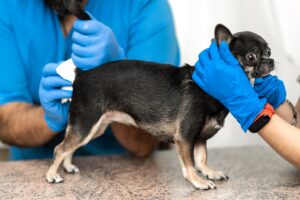
Unfortunately, anal sac disease in dogs is prevalent.
If you have observed your dog scooting across the room on their bottom, it could indicate anal sac disease. Dogs have two minor pouches on either side of their anus. They make a smelly brown fluid that canines use to identify each other and mark their territory. It is why they often sniff each other’s behinds. Let’s explore this uncomfortable disease more below.
Functions of Anal Glands
The anal sac secretion contains chemicals that behave as territorial markers or dog-calling cards. Anal sac fluid is typically squeezed out by muscular contractions whenever the canine passes a bowel movement, providing a unique scent signature to the feces. This is why dogs are interested in smelling one another’s feces.
What is Anal Sac Disease?
Unfortunately, anal sac disease in dogs is prevalent. The sacs often become plugged because the ducts get inflamed. The secretion within the plugged sacs will thicken and swell, making it painful for your dog to poop. The secreted material inside the anal sacs is an ideal source for bacterial growth, allowing abscesses to develop. Bacteria typically present in the feces may readily go up the ducts and enter the sacs. If the sacs are impacted, the fluid doesn’t empty normally and becomes infected. The fluid then becomes bloody, and the sacs will eventually become filled with pus, developing an anal sac abscess. With nowhere to go, if left untreated, the sac will eventually rupture from the buildup of fluid and pressure.
Causes of Anal Sac Disease
The first sign of anal sac disease in dogs is often dragging or scooting the rear end along the ground. There might be excessive licking or biting, often at the base of the tail instead of the anal area. If the anal sac ruptures, you might notice blood or pus draining from around the rectum. Anal sac disease is uncomfortable, and even ordinarily, gentle dogs might growl or snap if you touch the tail or anus if they have it.
Treatment
The treatment for anal sac disease in dogs is to release the sacs and flush out the solidified material. This is done by expressing the sacs manually from within the rectum. If infection is present, infusing the affected sac with anti-inflammatory and antibiotic medication might also be necessary. Because this can be painful, treatment might require sedation. Most dogs will respond excellently to pain relief medicine and antibiotics prescribed for multiple days until the swelling and inflammation are gone. Because anal sac disease is often a recurring issue, our vet will also let you know when your dog should be re-examined. Dogs with persistent anal sac disease can have their glands expressed regularly to prevent infection and impaction.
HERE AT MOUNT CARMEL ANIMAL HOSPITAL, WE’LL TREAT YOUR PETS LIKE FAMILY!
Mount Carmel Animal Hospital has been serving the Northern Baltimore/Southern York community for over 30 years and is proud to be an independently operated, small animal practice committed to excellence in veterinary medicine and client service. From grooming to wellness services, along with Canine Life Skills Training Courses, and surgical procedures, we have the expertise that will best serve the needs of you and your pet. Contact us at 410-343-0200 and follow us on Facebook
